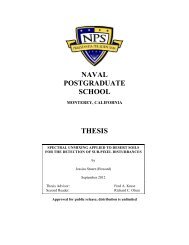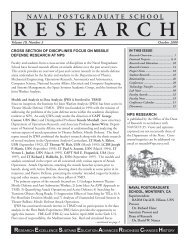GCSC Newsletter - July 2009 - Naval Postgraduate School
GCSC Newsletter - July 2009 - Naval Postgraduate School
GCSC Newsletter - July 2009 - Naval Postgraduate School
Create successful ePaper yourself
Turn your PDF publications into a flip-book with our unique Google optimized e-Paper software.
Volume 1, Issue 2<br />
In the Spotlight<br />
News and Updates<br />
Defense Institute for Medical Operations (DIMO)<br />
Page 11<br />
The Defense Institute for Medical Operations (DIMO), located at Brooks City-Base, Texas hosted its annual Executive Healthcare Resource<br />
Management (EHRM) course from 13-24 April <strong>2009</strong>. The two-week course was held at the USAF <strong>School</strong> of Aerospace Medicine and was<br />
conducted with the following objectives: to assist foreign nations with resolution of military healthcare management challenges; to provide<br />
graduate level education to facilitate the development of military healthcare practices; and, to increase awareness of the impact of access,<br />
quality and cost-effective healthcare services on the force health protection of military and civilian personnel. The 22 subject matter experts<br />
(SMEs) that instructed the course were comprised of U.S. Navy and U.S. Air Force from Brooks City-Base, Fort Sam Houston, and Lackland<br />
Air Force Base, and civilian instructors from local universities.<br />
Outside the classroom, the participants visited the Audie L. Murphy Memorial Veterans Hospital, Wilford Hall Medical Center, Brooke Army<br />
Medical Center, University Hospital and the U.S. Air Force Expeditionary Medical Support (EMEDS) facility to view “best practices” in<br />
healthcare. The three participants from Armenia, Lebanon, and Sierra Leone experienced social, economic, and historic aspects of<br />
American and Texas culture through the Field Studies Program.<br />
DIMO continues to support the Combatant Commanders’ Theater Security Cooperation efforts through medical engagement with partner<br />
nations. Since the beginning of this fiscal year, DIMO’s teams of SMEs have trained over 400 foreign military and civilian personnel<br />
representing almost 50 countries. The vast majority of these training programs took place in the host<br />
nation and covered a diverse list of subjects ranging from disaster response and trauma systems<br />
management to aeromedical evacuation principles and preventive medicine for deploying forces.<br />
Inter-American Air Forces Academy (IAFFA)<br />
LCDR Tina Jangel, Director, Healthcare Policy/Management at DIMO<br />
is pictured with students from Armenia, Lebanon, and Sierra Leone<br />
who attended the Executive Healthcare Resource Management Course<br />
conducted by DIMO 13-24 April <strong>2009</strong><br />
Gateways to the Americas: Promoting Partnership through Education<br />
Amidst the roar of a C-5 Galaxy taking off from the flight line, guest instructor Jacob Garcia Hernandez is showing Mexican cadets the inner<br />
workings of the UH-1H Huey helicopter inside a hangar. Garcia, a Master Sergeant in the Colombian Air Force, has been at Lackland’s Inter-<br />
American Air Forces Academy for almost two years teaching three courses in helicopter maintenance and providing hands-on, on-the-job<br />
practical training to cadets.<br />
“I’m here to share the knowledge I’ve acquired in my country over the years and pass it on to the students, and hopefully bring back new<br />
ideas back to my country, especially in the progress of technology,” said Master Sgt. Garcia. He also explained how students receive a<br />
person-to-person education, as opposed to the typical teacher-student dynamic. And just because a student graduates, it doesn’t mean the<br />
end of the learning process.<br />
IAAFA’s courses, which range from two to 12 weeks, are far-reaching, and students who receive their golden wings upon graduation wear<br />
them with pride. Throughout South America, pilots who have passed through IAAFA’s instrument flight procedures training are considered<br />
some of the best and the brightest.<br />
Students who attend longer courses are also given the opportunity to attend the field studies program, which allows cadets to participate in<br />
cultural and educational events and visit local and state government institutions. The program gives<br />
students a balanced understanding of the United States culture, society, and way of life.<br />
“All the people who have come through IAAFA and the other U.S. service schools will have contacts<br />
here...and that’s what we ultimately want to do,” said Col. Maria Cordero, IAAFA Commandant. “We<br />
want to forge those partnerships that will enable us to continue to talk to each other as fellow military<br />
members no matter what happens with the politics.”<br />
It is precisely these types of partnerships that have been and continued to be cultivated at schools like<br />
IAAFA that have paved the way for regional cooperation and a different perspective on relationships.
















